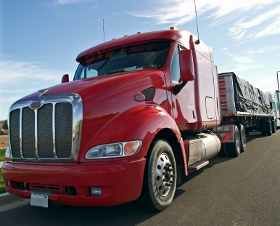Where To Set The Tandems ?
Topic 2294 | Page 4

I'm totally new to the job and I was wondering if there were some kind of formula to go by as to where the tandems should be placed based on the weight until a guy has time to get on a scale ?
I have had to slide the 5th wheel before to get legal.
Tandems:
Tandem Axles
A set of axles spaced close together, legally defined as more than 40 and less than 96 inches apart by the USDOT. Drivers tend to refer to the tandem axles on their trailer as just "tandems". You might hear a driver say, "I'm 400 pounds overweight on my tandems", referring to his trailer tandems, not his tractor tandems. Tractor tandems are generally just referred to as "drives" which is short for "drive axles".
Tandem:
Tandem Axles
A set of axles spaced close together, legally defined as more than 40 and less than 96 inches apart by the USDOT. Drivers tend to refer to the tandem axles on their trailer as just "tandems". You might hear a driver say, "I'm 400 pounds overweight on my tandems", referring to his trailer tandems, not his tractor tandems. Tractor tandems are generally just referred to as "drives" which is short for "drive axles".
New Reply:
New! Check out our help videos for a better understanding of our forum features

















Preview:
This topic has the following tags:
Driver Responsibilities Safe Driving Tips







 TT On Facebook
TT On Facebook
Susan giving really good and of course, smart advice:
I think it's important to realize that the rule of thumb for safely and legally setting the tandems ,... many times there isn't one. The best you can hope for is an educated guess, but unless hitting a scale, expect to be wrong at least once in a while. Unless every pallet is close to the same weight, and you are not "cubed-out", putting the tandems under the load, may work,... and it may not. Depends.
Here is my point:
Yesterday my trailer was loaded with 29 pallets and a spacer (8 pallets wrapped together), thus "cubed-out" from nose to tail. The weight of the load was 42,125 pounds. When I picked up the trailer, the tandems were in the 8 hole. Now usually that will work...but since my job is delivering to Walmart grocery stores, multiple stops on one trailer, without going through each and every invoice line-item (uh,... no), no way I can tell for sure if the 8-hole is legal and balanced without scaling. Walmart gives us a sealed trailer, there is no opportunity to inspect the inside. So,...as I do every time, I scaled the load (before leaving the DC) and it confirmed the 8-hole was good; 32,200 on the drivers, 32,400 on the tandems. To play this out a step further, the first store stop was three-pallets, plus the spacer. Much to my surprise the first three pallets off were all water weighing in at about 2200 pounds each. Once they were off and I was re-sealing for the second stop, the pallets occupying positions 25 and 26 were paper towels,...about 300-400 pounds each. To complete this dog's breakfast of variety, the last 3 pallets off, on the nose of the trailer, again water...which now makes sense, it balanced out the heavy tail.
No two loads are ever alike for me...gotta scale it every time.
The inverse to the above, and to Susan's point, for me most back hauls, especially bottled water, I always run with the tandems in the 7-hole. Always loaded the same (to the 44' mark), each pallet weights between 2200-2300 pounds. So the point made is an excellent rule of thumb for any load made up of basically the same freight, with a consistent weight and volume for each pallet.
Tandems:
Tandem Axles
A set of axles spaced close together, legally defined as more than 40 and less than 96 inches apart by the USDOT. Drivers tend to refer to the tandem axles on their trailer as just "tandems". You might hear a driver say, "I'm 400 pounds overweight on my tandems", referring to his trailer tandems, not his tractor tandems. Tractor tandems are generally just referred to as "drives" which is short for "drive axles".
Tandem:
Tandem Axles
A set of axles spaced close together, legally defined as more than 40 and less than 96 inches apart by the USDOT. Drivers tend to refer to the tandem axles on their trailer as just "tandems". You might hear a driver say, "I'm 400 pounds overweight on my tandems", referring to his trailer tandems, not his tractor tandems. Tractor tandems are generally just referred to as "drives" which is short for "drive axles".
CAT Scale:
A network of over 1,500 certified truck scales across the U.S. and Canada found primarily at truck stops. CAT scales are by far the most trustworthy scales out there.
In fact, CAT Scale offers an unconditional Guarantee:
“If you get an overweight fine from the state after our scale showed your legal, we will immediately check our scale. If our scale is wrong, we will reimburse you for the fine. If our scale is correct, a representative of CAT Scale Company will appear in court with the driver as a witness”